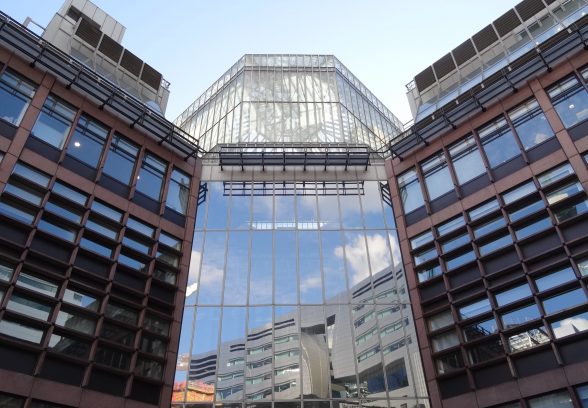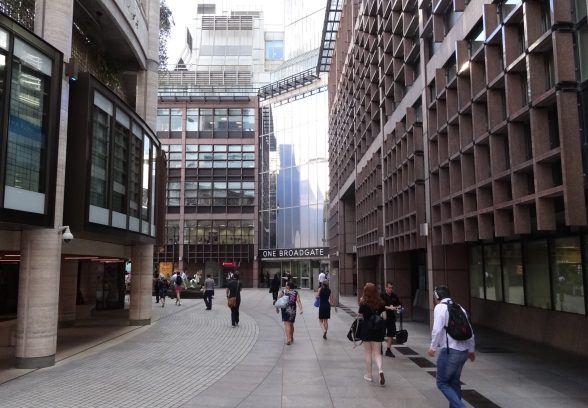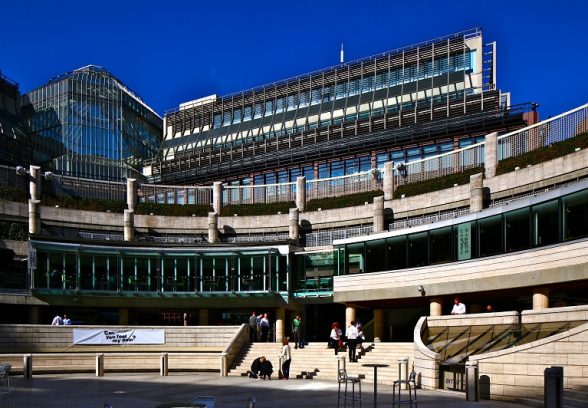This website uses cookies
This website uses cookies to enable it to function properly and to analyse how the website is used. Please click 'Close' to accept and continue using the website.





It is with great regret that we announce the end of our eight-year campaign to save the outstanding 1980s Peter Foggo London office complex. This follows the disappointing recommendation by Historic England that 1-2 Broadgate, the last surviving unaltered element of the scheme, should not be listed and that a Certificate of Immunity be granted.
C20 Caseworker Grace Etherington said: “It is a great shame that Broadgate’s legacy will be associated with the failure of DCMS to follow expert opinion, and we are disappointed that inadequacies in the listing process will result in the loss of London’s most significant and successful post-war commercial development.”
The Broadgate masterplan and phases 1-4 were designed by Peter Foggo for Arup Associates and built between 1985 and 1987. Later additions were designed by Chicago based architects Skidmore, Owings and Merrill. The complex was widely celebrated as the country’s most outstanding office development built during the 1980s financial boom, and was praised for its exceptionally high quality, carefully planned public realm and prestigious collection of purpose-designed artworks.
Phases 1-4 received the Civic Trust Special Award in 1989, and in 1991 the Arup contributions were named by the RIBA as both their regional and national Building of the Year. In 1988 the unfinished complex received the British Construction Industry Supreme Award and the Structural Steel Design Award, highlighting the speed and efficiency of the pioneering construction methods used. The Royal Town Planning Institute’s Silver Jubilee Cup was awarded to the completed development in 1992.
Broadgate is now owned by British Land and over recent years a range of redevelopment schemes have destroyed the coherence of the scheme as a whole. We deeply regret the loss of 4 and 6 Broadgate, the addition of 5 Broadgate by MAKE Architects, and the unrecognisable remodelling of 3 Broadgate, 8-12 Broadgate and 100 Liverpool Street. The accumulated changes to the Broadgate Circle (former Arena) and the landscaped public realm have fundamentally changed the way the site functions as public space. Rab Bennetts, a member of Peter Foggo’s team at Arup during the 1980s, described the central piazza as “something unique in London”. (National Life Story Collection: Architect’s Lives)
Our campaign has supported Historic England’s previous recommendations that Phases 1-4 hold substantial group value and should be awarded statutory protection through listing. In 2011 Historic England (then English Heritage) carried out their first assessment of Broadgate and recommended the whole group be listed at Grade II*, which was then unheard of for a building that was only 26 years old. The Secretary of State for Culture Media and Sport chose to ignore English Heritage’s recommendation and refused to add Broadgate to the National Heritage List for England. This allowed the demolition of 4 and 6 Broadgate, and the remodelling of 3 Broadgate. In 2012 English Heritage recommended that the remainder of Broadgate phases 1-4 be reassessed for listing in 2015 once they had reached 30 years old (the standard criteria). HE’s assessment in 2012 recommended the surviving elements of phases 1-4 be listed at Grade II in 2015 once they had reached 30 years old, reflecting the damage that recent losses had caused on the significance of the whole scheme. DCMS again chose to ignore this recommendation, and issued a second Certificate of Immunity from Listing. In the three years since this decision, work has started on a redevelopment scheme for 8-12 Broadgate and 100 Liverpool Street, which will strip the building back to its steel frame and add a new curved glazed façade, removing all elements of Foggo’s original vision.
In August Historic England were asked to assess 1-2 Broadgate for listing, with the wider threat of plans for a new AHMM building on the site being circulated. This was the first time that an individual Broadgate building had been assessed for listing, rather than all of phases 1-4. It was also the first time that a Broadgate building would be assessed against the less stringent criteria for buildings over 30 years old. We supported listing for 1-2 Broadgate at Grade II, owing to its prominence as the last surviving element of Arup’s award winning design and as an outstanding example of ambitious speculative office development in the City of London during the 1980s.
Historic England have now issued their recommendation that 1-2 Broadgate should not be listed, and a Certificate of Immunity from listing should be granted. This decision is tantamount to waving through the building’s inevitable demolition, and marks the end of the campaign to save the scheme.
Historic England provide an almost elegiac summary of Broadgate’s importance: ‘It was an exemplar of urban place-making; critically acclaimed, commercially successful and highly influential, its importance in the canon of English commercial architecture is without question.’
We recognise and regret the loss of the total composition of Broadgate, and are disheartened that its specialness and most distinguishing qualities have been allowed to deteriorate. Questions need to be asked as to how this came about and why DCMS time and again ignored recommendations from its own appointed advisors, until the integrity of the scheme had become irreversibly compromised.

Become a C20 member today and help save our modern design heritage.